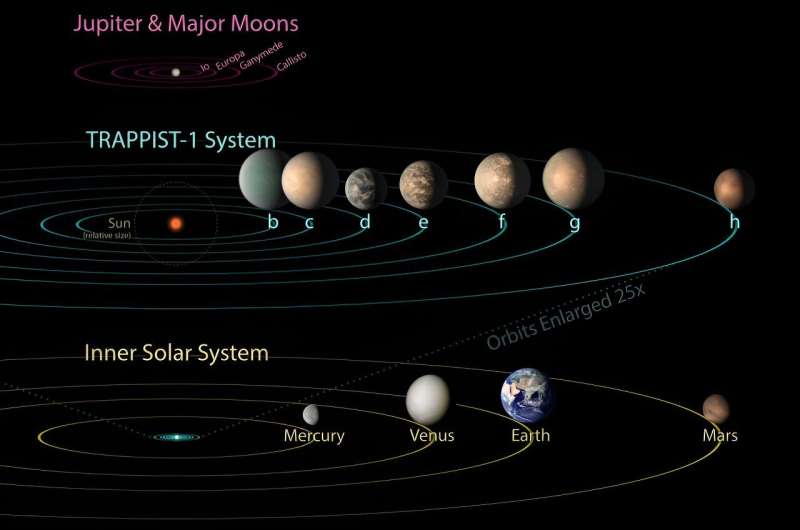This article has been reviewed according to Science X's editorial process and policies. Editors have highlighted the following attributes while ensuring the content's credibility:
fact-checked
peer-reviewed publication
trusted source
proofread
The evolution of the Trappist-1 planetary system

Planets are bodies that orbit a star and have sufficient gravitational mass that they form themselves into roughly spherical shapes that, in turn, exert gravitational force on smaller objects around them, such as asteroids and moons.
For most of human history, the only planets our ancestors knew of were those they could see in the night sky. But in the last 30 years, telescopes sensitive enough to infer the presence of exoplanets—planets outside our own solar system—have been developed.
Exoplanets are, of course, much more difficult to directly observe than stars and galaxies. Almost all exoplanet discoveries, particularly starting around 2010, have been based on photometric measurements (the amount of light received) of the exoplanets' host stars, rather than of the planets themselves. This is called the transit method.
Now, with the help of the Spitzer Space Telescope, which made its own first exoplanet detection in 2005; the Kepler/KW Space Telescope, specifically designed to search for exoplanets; and the James Webb Space Telescope, launched in 2021, the transit method and other techniques have confirmed the existence of more than 5,000 exoplanets inhabiting thousands of star systems.
"When we had only our own solar system to analyze, one could just assume that the planets formed in the places where we find them today," says Gabriele Pichierri, postdoctoral scholar research associate in planetary science at Caltech, working in the group of Professor of Planetary Science Konstantin Batygin.
"However, when we discovered even the first exoplanet in 1995, we had to reconsider this assumption. We are developing better models for how planets are formed and how they come to be in the orientations we find them in."
Most exoplanets form out of the disk of gas and dust around newly formed stars and are then expected to migrate inward approaching the inner boundary of this disk. This assembles planetary systems that are much closer to the host star than is the case in our own solar system.
In the absence of other factors, planets will tend to space themselves apart from one another at characteristic distances based on their masses and gravitational forces between the planets and their host star. "This is the standard migration process," Pichierri explains.
"The positions of the planets form resonances between their orbital periods. If you take the orbital period of one planet and then you divide it by the orbital period of its neighboring planet, you get a ratio of simple integers, such as 3:2."
So, for example, if one planet takes two days to orbit around its star, the next planet, farther out, will take three days. If that second planet and a third one farther out are also in a 3:2 resonance, then the third planet's orbital period will be 4.5 days.
The Trappist-1 system, which hosts seven planets and is located about 40 light years from Earth, is a special one for multiple reasons. "The outer planets behave properly, so to speak, with the simpler expected resonances," Pichierri says. "But the inner ones have resonances that are a bit spicier."
The ratio between planet b and c's orbits is 8:5, for example, and that between c and d is 5:3. "This narrow discrepancy in the outcome of Trappist-1's assembly is puzzling and represents a wonderful opportunity to figure out in detail what other processes were at play in its assembly," he says.
"In addition, most planetary systems are thought to have started in these resonant states but have encountered significant instabilities in their lifespan before we observe them today," Pichierri explains. "Most planets go unstable or collide with one another, and everything gets shuffled.
"Our own solar system, for example, was affected by such an instability. But we know of a few systems that have remained stable, that are more or less pristine specimens. They, in effect, exhibit a record of their entire dynamical history that we can then attempt to reconstruct. Trappist-1 is one of these."
The challenge then was to develop a model that could explain the orbits of the Trappist-1 planets and how they reached their current configuration.
The resulting model suggests that the inner four planets initially evolved alone in the expected 3:2 resonance chain. It was only as the disk's inner boundary expanded outward that their orbits relaxed out of the tighter 3:2 chain into the configuration we observe today.
The fourth planet, which originally sat on the inner boundary of the disk, moving farther out along with it, was later pushed back inward when three additional outer planets joined the planetary system at a later stage.
The paper containing this research, titled "Forming the Trappist-1 system in two steps during the recession of the disk inner edge," is published in Nature Astronomy.
"By looking at Trappist-1, we have been able to test exciting new hypotheses for the evolution of planetary systems," Pichierri says. "Trappist-1 is very interesting because it is so intricate; it's a long planetary chain. And it's a great exemplar for testing alternative theories about planetary system formation."
More information: Gabriele Pichierri et al, The formation of the TRAPPIST-1 system in two steps during the recession of the disk inner edge, Nature Astronomy (2024). DOI: 10.1038/s41550-024-02342-4. On arXiv DOI: 10.48550/arxiv.2406.08677
Journal information: Nature Astronomy , arXiv
Provided by California Institute of Technology




















